Boosting Topical Authority with SEO Content Strategies & ChatGPT
Kate Smoothy
Posted 6 March, 2024 by Kate Smoothy in Content
Boosting Topical Authority with SEO Content Strategies & ChatGPT
Despite being a new buzzword you’ve likely seen one too many LinkedIn influencers writing about, topical authority is not a new concept in the SEO world. Being a reliable source of information in your niche has helped websites rank on Google for years.
After all, it’s why many passion bloggers have managed to turn their hobbies into their full-time jobs.
Nowadays, most people have wised up to topical authority (hence why the LinkedIn bros are talking about it) and are much more strategic in their approach. However, many people fail because, as you soon find out, it’s not a five-minute job.
Even the most dedicated website owners often find their pursuit for topical authority doesn’t quite hit the mark, or they just can’t compete with key players who have been at it for years.
Fortunately, we’re in the era of ChatGPT. And while it’s got a long way to go to replace digital marketers in their day jobs, when you use it correctly, ChatGPT is the perfect tool to support you on your quest for topical authority.
This article is a guest contribution from Kate Smoothy, SEO specialist and the founder of Webhive Digital.
How Topical Authority Works for SEO
In a nutshell, the more Google trusts that your website “knows its stuff”, the more likely they are to boost your website’s rankings on SERPs.
For that to happen, you need to post a lot of relevant content on a regular basis, strategically split up into subtopics. For example, if I was looking to accomplish topical authority, rather than covering this in all one post, I could split it into at least three:
- How Topical Authority Works for SEO
- How to Use Content Strategies to Build Topical Authority
- How to Use ChatGPT to Create SEO Content Strategies
This opens up more ranking opportunities, as you can target a variety of medium and long tail keywords, internally link between posts and increase your website’s engagement rates.
Content Strategies & Topical Authority
Establishing topical authority is not about posting a load of articles and calling it a day. It’s a lot more strategic and requires a long-term content strategy with steady posting schedules, digging deep into your topic, thinking outside the box and, most importantly, a lot of planning.
Many people skip over the planning part of this process because it’s time-consuming and requires you to think 10+ steps ahead of where you’re currently at.
But that’s the point.
Your content strategy is designed to keep you in check. Otherwise, it’s all too easy to cannibalise content, overlook content gaps, or simply not quite achieve that “trusted source” status you’re trying to achieve.
Ideally, you should begin your content strategy by creating content clusters for the “main groups” related to your overall topic. For example, this blog post could sit within a “Content Strategies” or “AI” cluster.
The idea behind clusters is that all the topics within them should be linked together by a common theme. If we go back to dividing this post into smaller posts, “How Topical Authority Works for SEO” and “How to Use Content Strategies to Build Topical Authority” would sit within the Content Strategies cluster.
Whereas “How to Use ChatGPT to Create SEO Content Strategies” could sit within the Content Strategies and AI clusters.
This allows me to:
- Find internal linking opportunities within clusters.
- Avoid duplicating content I’ve already covered.
- Find content gaps within clusters where I need to publish more content.
If you’re like me, then you’re into this idea, but not how long it takes.
Luckily, we can speed up this process.
How to Use ChatGPT to Create Your SEO Content Strategy
I want to preface this by saying that I’m not the biggest fan of how most people use ChatGPT for SEO.
The content outputs are very obviously written by AI, the keyword research doesn’t provide any helpful (or accurate data), and it doesn’t go in-depth enough without so much prompting that you may as well have written it yourself.
But when it comes to content strategies, it’s your new best friend.
Generating Content Ideas & Clusters
Whether you’re unsure about what topics to cover within your niche or feel like you’re missing some (hint: you probably are), this is a good place to start.
Use a prompt like the one below and keep your niche/industry description as broad as possible. The aim here is to create your main clusters, so you want to keep things as broad as possible so we can drill it down later.

This prompt gave me a total of eight clusters which is a great starting point. Depending on your niche, you might find you only get 3-5 suitable ones. If you feel you’re missing some, try describing your niche in a different way, or skip to “Competitor Analysis” below to expand more before you continue.
Expanding Clusters
Once you’ve established your top-level clusters, it’s time to flesh them out and really drill things down to specifics. Treat each cluster as its own topic and ask ChatGPT to create clusters for each.

Once you’ve got your next level of clusters, you can continue to rinse and repeat this until you’ve drilled down clusters so specific that they’re more like single blog post topics than clusters (i.e. they’re super specific and can’t be split into multiple topics without losing all meaning).
In the example above, the clusters would not be specific enough to cover skin care in-depth. So I asked ChatGPT to create clusters for “Daily Skincare Routines”, which gave me this:

Still not quite specific enough, so I went in again with a more specific “Morning Skincare Routine” cluster to get the following, which are perfect for blog post topics within the cluster:
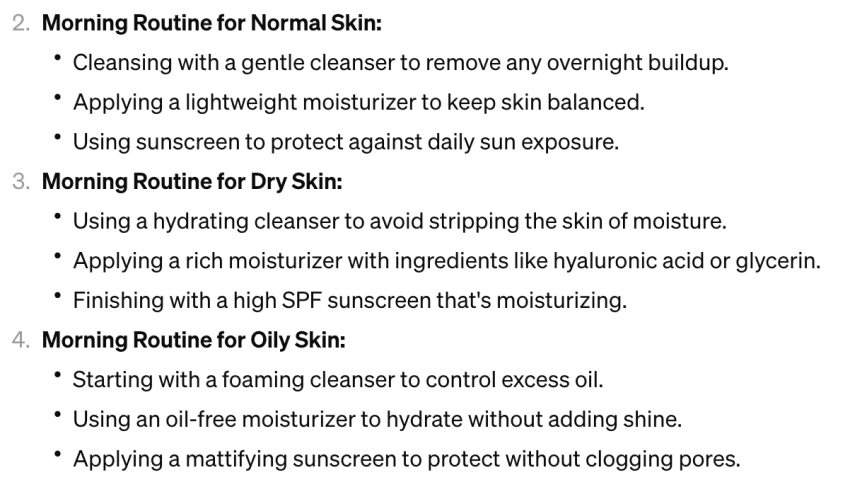
To be honest, I’m tempted to go one further with this and have a cluster for “Morning Routines for Oily Skin” and have blog posts covering each of the bullet points – but I think you get the idea!
Competitor Analysis
If you followed the methods above, chances are you already have quite a fleshed-out content strategy. But there’s always room for improvement! And what better way to do it than by a little bit of healthy competitor analysis?
This one requires your competitor’s URL and a simple prompt to reverse-engineer the website’s content strategy:
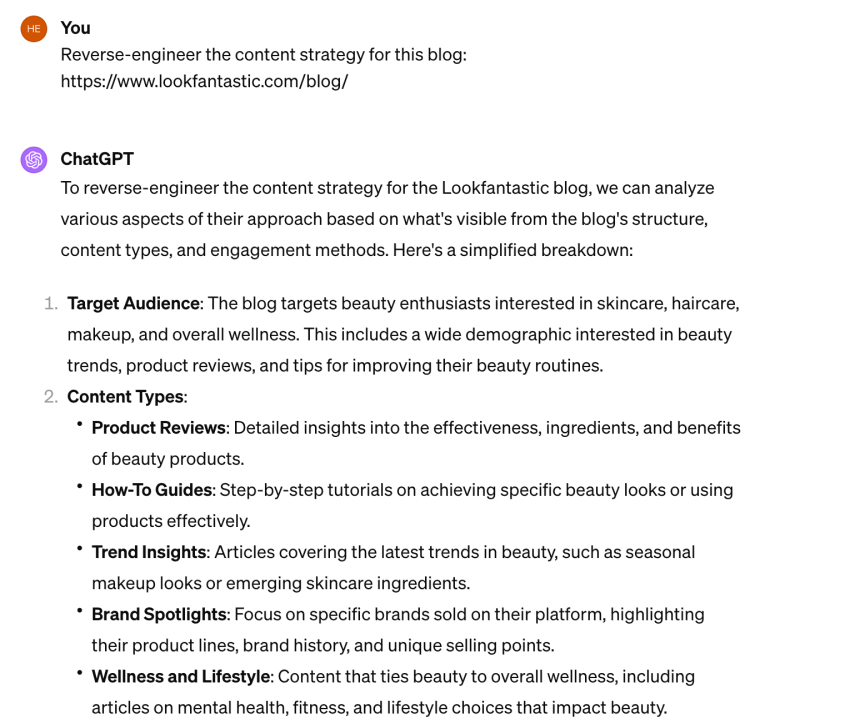
Just like we did before, now we’re going to drill down by each section until we get the level of information we need to add to our own content strategies:
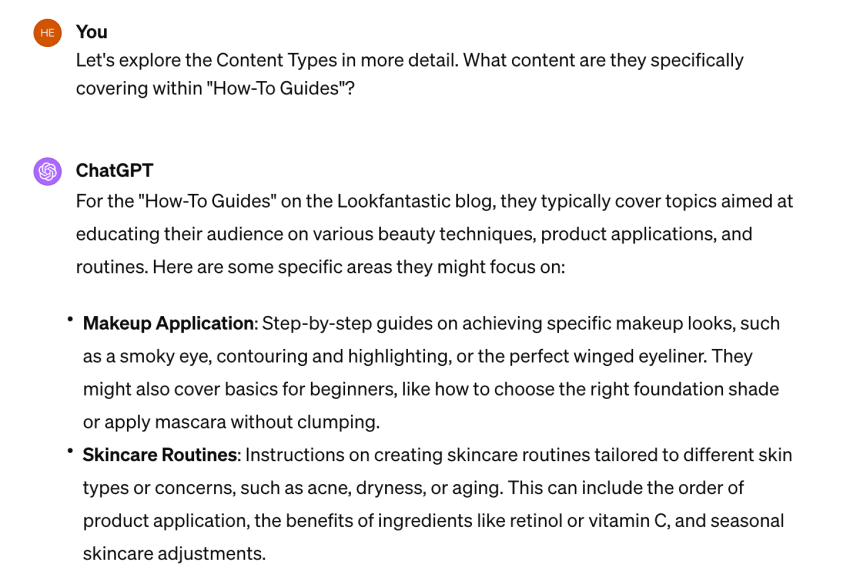
Note: If you add any new main clusters to your content strategy using this method, go back to the last step and properly expand the cluster, as your competitor may not have done, and you don’t want to miss anything.
Implementing Your Content Strategy
Once you’ve pieced together all your findings, it’s time to start implementing them. I’m going to assume that you’re creating a content strategy for an existing site, in which case, you’ll probably have published content that aligns with topics in your content strategy.
In these instances, you’ve got two options:
- Mark it as complete in your content strategy and move on to the next one.
- Update the content.
Whether or not you update the content depends on how the existing post/page is currently ranking, the relevance to the topic in your content strategy and when it was last updated.
If the existing content ranks well for searches related to the topic, I would mark it as complete. If the content isn’t ranking well and hasn’t been updated in over a year or is low-quality, I would update it.
I don’t recommend feeding the article to ChatGPT with a prompt to have it update the content for you. It won’t go in-depth enough, you can’t trust its up-to-date data, and you’re more likely to lose anything valuable from your original content than gain anything out of it.
Instead, have ChatGPT help you craft a new outline that fits well with the new topic.
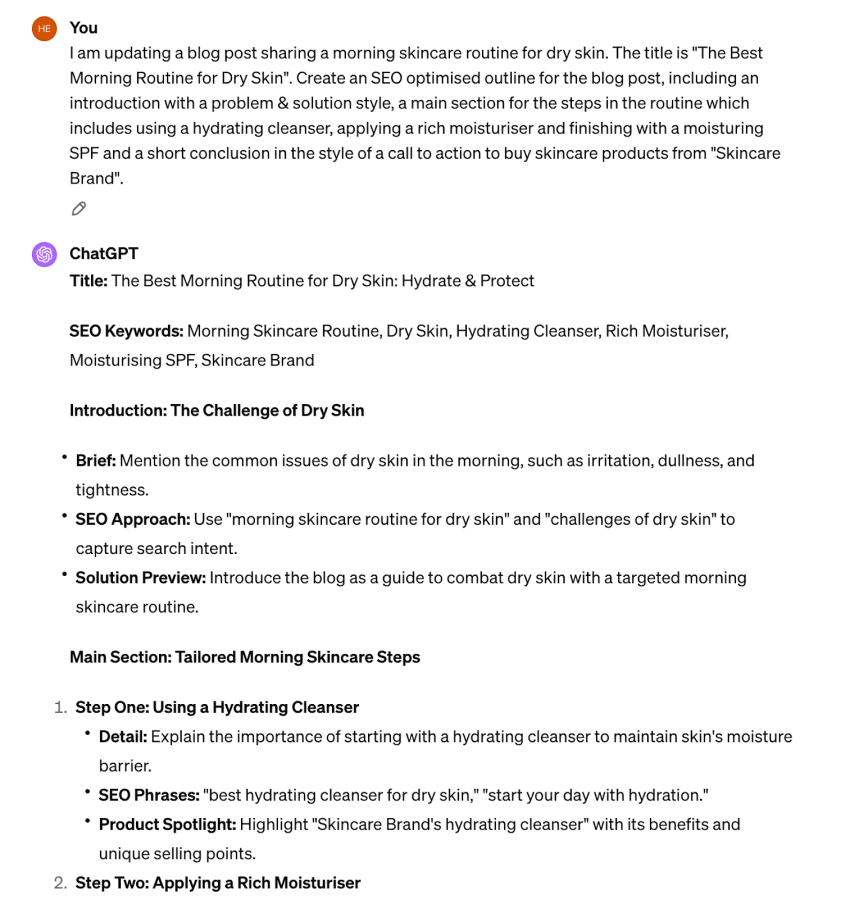
Note: The keywords and headings it provides are usually pretty basic and can’t replace data-driven keyword research.
Now you’ve got your outline, it’s time to ask ChatGPT to incorporate your existing content into the outline.
Prompt

Outline
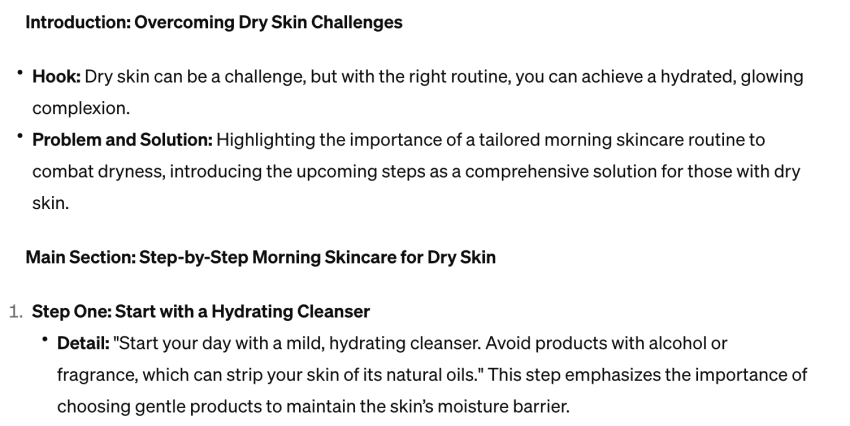
The introduction and conclusion still need to be written in this example, but the existing content I gave ChatGPT has been entered into the outline. From here, you can continue to feed it different bits of information to fill out the outline or simply prompt to write the rest of the blog post using your brand’s tone and style.
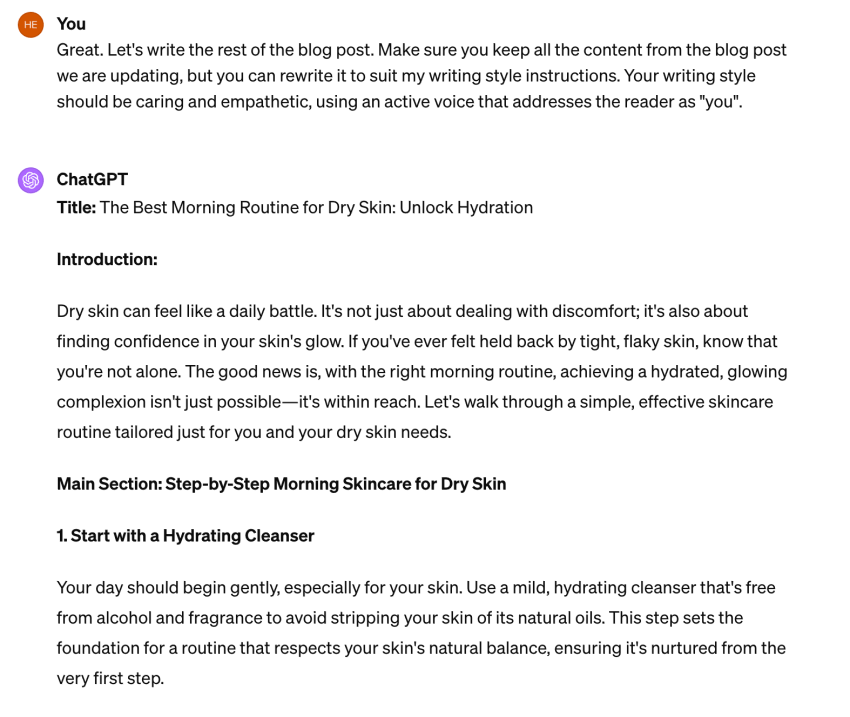
This should give you a nicely fleshed-out first draft for your updated blog post. From here, take the time to edit the content to remove anything that isn’t true, expand areas that are a bit light on detail and aim to cover the topic as in-depth as possible.
For example, you could add sections to help people identify if they have dry skin, what ingredients to avoid and general guidelines to follow when creating their own dry skin skincare routine.
As a final step, you can even feed ChatGPT a list of topics from your cluster and ask it to identify internal linking opportunities from this blog post to the other topics, like this:
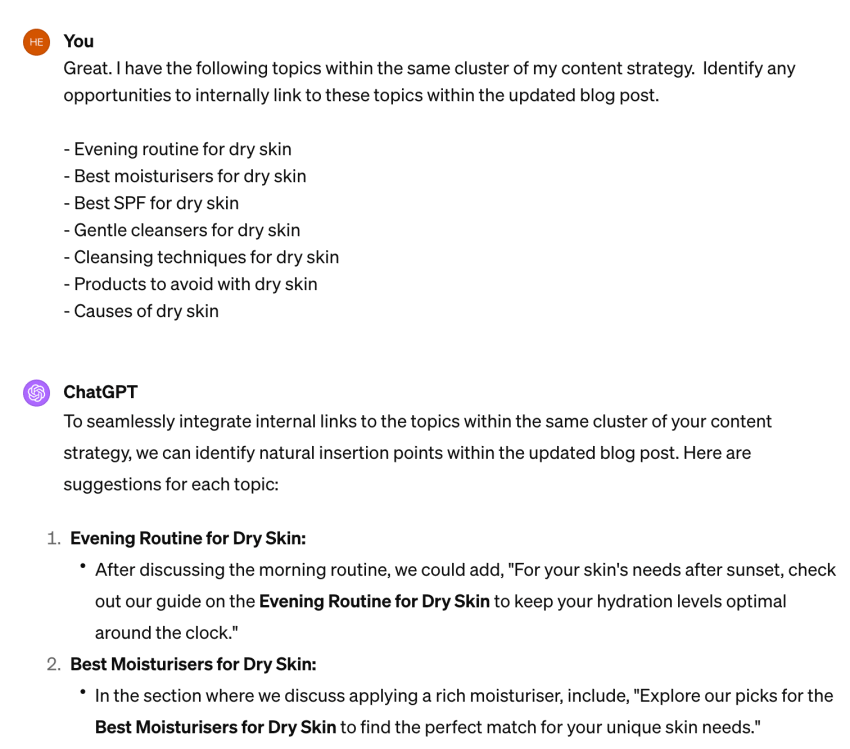
Updating Your Content Strategy
Once all your existing content has been incorporated, you can start planning your schedule for posting new content from your strategy, researching keywords and creating content outlines for the topics you’re set on for each cluster.
As it’s a guide you should follow long-term, aim to update your content strategy every 2-3 months to add new clusters/posts, look for content gaps and ultimately, make sure it still aligns with your goals. After all, that’s the point, right?!







Hi there,
The above article is great and full of highly valuable information. However i am just confused as you mentioned that to increase topical authority you should create multiple articles instead of one. But if we speak as per Semantic SEO standards woudnt that be great if we cover all the topics in one blog rather than creating multiple topics that revolves around the same topic?
Looking forward to hear from you.
Thanks & Regards
Shahab
You can still use a semantic SEO approach with this, if anything, you can use this approach better by niching things in this way. For example, if you are writing about a specific skin type and the best morning routine, you can go into detail about the ingredients, products, order of application, etc. that works best for that skin type and the time of day. If you were to try and do a huge blog post for all skin types, the content would be very diluted for each if your tried to provide the same level of detail.
Hi kate,
Thanks for you reply.
As per my understading you are saying that if make our blog post relatively large than it will dillute the content. So it means the best way is to create separate pages for each topic relevant to your main context.
Can you please tell me would that be okay if i create multiple pages to cover different aspects of the topic with the word count of minimum 500?
Thanks & Regards
Shahab
Great insights, Kate! Implementing clusters for content strategies seems like a game-changer. Curious, have you noticed any specific challenges or successes in maintaining topical authority over time?
After a while, you need to get more creative with topics, as you eventually work through all the “logical” topics. But the idea is this work gives you enough of an authority boost that you can expand to related topics easier :).
Thx Kate, awesome info we use ChatGPT also and this makes it easier. Thx